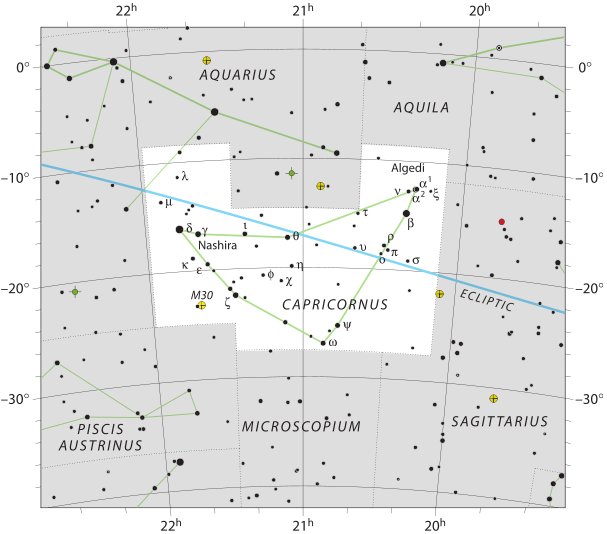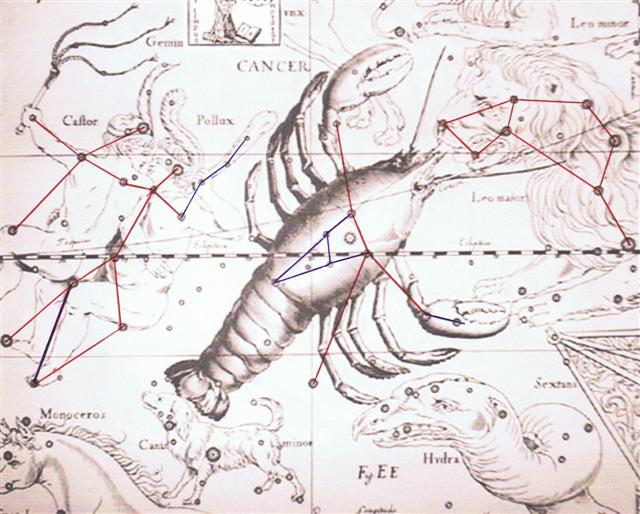The birth of a new child (tamaiti) could be followed by the death of someone in the older generation, and in the idiom of rongorongo this may have been illustrated by the koti type of glyph (like an egg shell breaking apart when the chicken emerges):
| August 10 |
11 |
12 |
13 (225) |
 |
 |
 |
 |
| Cb6-1 (508) |
Cb6-2 |
Cb6-3 |
Cb6-4 |
| E haga o tere hia - te manu |
manu gutu pao hia - tagata |
te marama |
| Al Minhar al Asad (141.6), Alphard (142.3) |
Al Tarf |
A Hydrae (144.1) |
Ukdah (145.4), κ Hydrae (145.5) |
| ω Leonis (142.6), τ¹ Hydrae (142.7), ψ Velorum (143.3), ALTERF, τ² Hydrae (143.4), ξ Leonis (143.5) |
| February 10 |
11 |
12 (408) |
13 |
| Al Sa'd al Su'ud / Emptiness |
Castra (327.2), Bunda (327.5) |
Nashira (328.0) |
Azelfafage, κ Capricorni (328.7), Enif, Erakis (329.2), Jih, 46 Capricorni (329.3), ι Piscis Austrini (329.4) |
| Alphirk (325.7), SADALSUD (325.9) |
| August 14 (591) |
15 |
16 (228) |
 |
 |
 |
| Cb6-5 (512) |
Cb6-6 |
Cb6-7 |
| ihe tamaiti |
kotia - te hokohuki |
kava haati |
| Subra (145.8), ψ Leonis (146.4) |
Ras Elaset Australis (146.6) |
Vathorz Prior (147.9), υ¹ Hydrae (148.4) |
| February 14 |
15 |
16 (412) |
| λ Capricorni (329.6), ν Cephei (329.7), Deneb Algiedi (329.8), θ Piscis Austrini (330.1) |
Kuh (331.4) |
no star listed |
Metoro seems to have chosen to read this koti glyph like a sign for a final:
| Koti Kotikoti. To cut with scissors (since this is an old word and scissors do not seem to have existed, it must mean something of the kind). Vanaga.
Kotikoti. To tear; kokoti, to cut, to chop, to hew, to cleave, to assassinate, to amputate, to scar, to notch, to carve, to use a knife, to cut off, to lop, to gash, to mow, to saw; kokotiga kore, indivisible; kokotihaga, cutting, gash furrow. P Pau.: koti, to chop. Mgv.: kotikoti, to cut, to cut into bands or slices; kokoti, to cut, to saw; akakotikoti, a ray, a streak, a stripe, to make bars. Mq.: koti, oti, to cut, to divide. Ta.: oóti, to cut, to carve; otióti, to cut fine. Churchill.
Pau.: Koti, to gush, to spout. Ta.: oti, to rebound, to fall back. Kotika, cape, headland. Ta.: otiá, boundary, limit. Churchill. |
| Tia (Tiha G) .To sew. T Mgv.: tia, to prick, to pierce, to stick in. Churchill.
Ta.: tia, the lower belly. Mq.: tia-kopu, pubes. Ma.: tia, the lower abdomen. Tiahonu, to piece together. Mq.: tuhonu, to mend, to patch. Ma.: tuhonu, to join. Churchill.
Mq.: tiaha, drinking cup. Ha.: kiaha, a cup, a mug. Tikao, to dig out, to disembowel. Ma.: tikaro, to dig out of a hole. Churchill. |
KIA. s. Haw., pillar or inner post of a house supporting the roof, any kind of pillar or post, a mast of a vessel; kia-aina, a supporter of the land, a governor of a province.
Marqu., tia, id.
Sam., ti'a, the stick used in tanga-tia, a man's head (abusively); tia-pula, taro-tops cut off for planting.
Sunda, tihang. Mal., tiang, a pillar.
Greek, κιων, a pillar, support of the roof, the identical sense of the Polynesian usage of the word. Liddell and Scott give no etymology or connections of κιων. (Fornander)
|
In the night sky of August 15 the last of the Greek-lettered stars in the Capricorn (μ) was close to the Full Moon:

| Greek mu |
Μ (μ) |
Phoenician mēm |
 |
Egyptian water ripples |
 |
The knowing observer would have drawn the conclusion that the southern part of the forehead of the Lion (Ras Elaset Australis) was with the Sun, i.e. in the day of August 15 the Lion may have begun for real with ε Leonis, at his cheek according to the picture of Hevelius:

Ras Elaset Borealis (μ, at the northern part of the Lion's head) rose heliacally 2 days later, in August 17 (229).
However, the Forehead (Al Jabhah) of the Lion was evidently according to the Arab manzil system connected with the time when the star Al Jabhah (η Leonis) rose with the Sun:
|
August 17 |
18 (230) |
19 |
20 |
 |
 |
 |
 |
|
Cb6-8 |
Cb6-9 |
Cb6-10 |
Cb6-11 |
| kiore |
te hokohuki |
kua tu te rau
hei |
te moko - te hokohuki |
|
Ras Elaset Borealis
(148.7) |
Tseen Ke (149.9), ν
Leonis (150.1) |
π Leonis (150.6) |
Al Jabhah
(10h,152.2) |
|
υ² Hydrae (151.8),
AL JABHAH (152.4) |
|
February 17 |
18 |
19 |
20 (416) |
|
η Piscis Austrini (333.4) |
Kae Uh (334.0), Al Kurhah (334.4) |
22h (334.8) |
Woo (335.7), Baham, τ Piscis
Austrini (335.8), ζ Cephei (336.2), λ Cephei (336.3) |
|
Sadalmelik (334.6), ι Aquarii, ν
Pegasi (334.7), ι Pegasi (335.0), Alnair (335.1), μ Piscis
Austrini, υ Piscis Austrini (335.3) |
| 1 |
Al Sharatain |
Pair of Signs |
β (Sheratan), γ Arietis (Mesarthim) |
27.4 |
April 17 (107) |
- |
0 |
| 2 |
Al Dabarān |
Follower |
α (Aldebaran), θ¹, θ²´, γ (Hyadum I), δ (Hyadum II), ε Tauri (Ain) |
63.4 |
May 23 (143) |
36 |
36 |
| 3 |
Al Hak'ah |
White Spot |
λ (Heka), φ¹, φ² Orionis |
84.4 |
June 13 (164) |
21 |
57 |
| 4 |
Al Han'ah |
Brand |
γ (Alhena), μ (Tejat Posterior), ν, η (Tejat Prior), ξ Gemini (Alzirr) |
93.4 |
June 22 (173) |
9 |
66 |
| 5 |
Al Dhirā' |
Forearm |
α (Castor), β Gemini (Pollux) |
113.4 |
July 12 (193) |
20 |
86 |
| 6 |
Al Nathrah |
Gap |
ε Cancri (Beehive) |
130.4 |
July 29 (210) |
17 |
103 |
| 7 |
Al Tarf |
End |
ξ Cancri, λ Leonis (Alterf) |
143.4 |
August 11 (223) |
13 |
116 |
| 8 |
Al Jabhah |
Forehead |
η Leonis (Al Jabhah), α (Regulus), ζ (Adhafera), γ (Algieba) |
152.4 |
August 20 (232) |
9 |
125 |
In rongorongo times day 125 (= 5 * 5 * 5) counted from the heliacal rising of Sheratan (β Arietis) was coinciding with 10h (August 20). The manzil structure was clearly built on stars which rose with the Sun at the same time in the day as Sheratan - all redmarked stars in my table above rose in RA days with the fraction .4 = that for Sheratan.
The End (kotia, Al Terf) in August when the Lion's forehead (Al Jabhah) rose with the Sun could be compared in the night with how Aquarius was marking the end for Capricornus.
The Water-man was the opposite of the Lion. 22h - 12h = 10h. Fire cannot join water - they are opposites. If Aquarius succeeded the Capricorn, then what constellation did Leo follow? If we keep to the zodiac through which Sun moves in the year the answer must be Cancer (a creature down in the water):
 Cancer and Leo are face to face (they meet in summer) while Capricornus and Aquarius both belong in the back side of the year.
|








